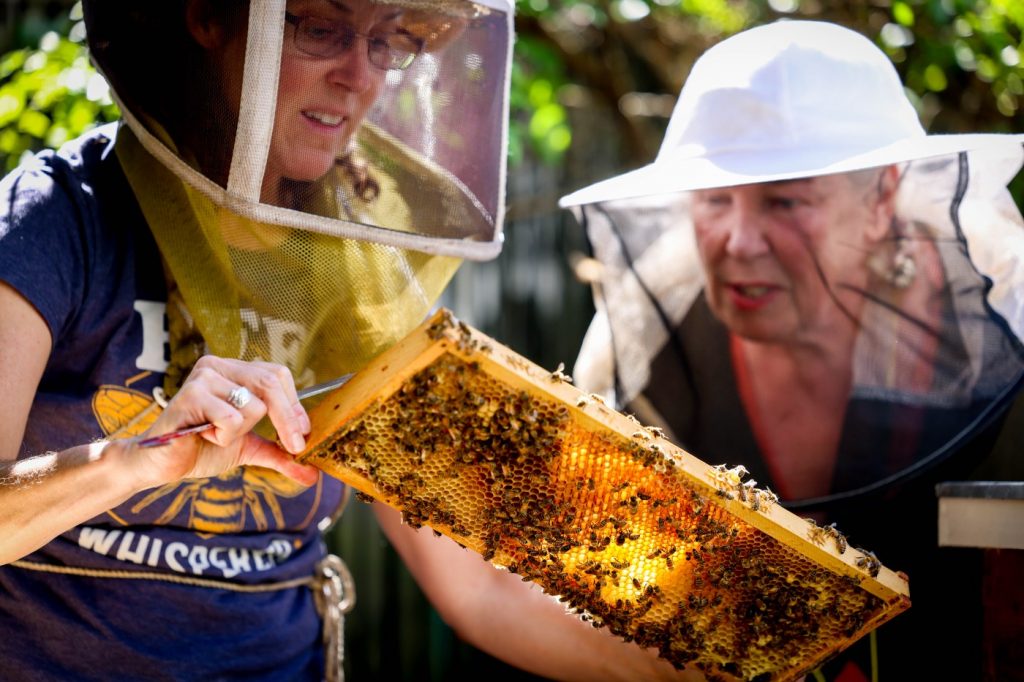It’s afternoon in an East Oakland neighborhood, and there’s a football-sized swarm of honeybees hanging at eye-level in a manzanita bush – the exact level, some might say, where you wouldn’t want to meet a football of bees.
The swarm started on a sidewalk, then floated like an insectoid buzzsaw into the shrub, at which point the anxious homeowners called the Alameda County Beekeepers Association.
Related Articles
Point Reyes seashore study favors elk fence removal
A strange fungus could transform emerging cicadas into ‘saltshakers of death,’ scientists say
San Jose woman wants to keep the squirrels in her yard, but ditch the rats
Use solar power, kill a tortoise? Climate change solution carries environmental costs
Scores of starving and sick pelicans are found along the California coast
Now, as bees dive-bomb and fly the loop-de-loop, beekeeper Paula Breen gently knocks them off the brush and into a plastic bucket. She then proffers the crawling mass like a maitre d’ presenting the night’s special menu.
“If you’re comfortable and want to put your face in this, you’ll get the sweet smell of the pheromones they’re producing to tell their sisters where to go,” says Breen, who lives in San Leandro. “I would describe it as the perfect marriage of lemon and lavender.”
The month of May in the Bay Area is swarm season, when hives spew forth clouds of bees seeking new homes. Thanks to winter rains and early blossoming, 2024 is shaping up to be active in every corner of the Bay, keeping beekeeper associations in every county as busy as — you know. The Alameda association’s hotline (510-898-6696) handled an average of 394 swarm calls during each of the last two years, but the tally was already over 250 by early May.
When bees swarm, it’s a tremendous site to behold.
Sweet Serendipity Honey beekeeper Paula Breen removes a swarm of bees from a home’s front yard and relocates them in a new box in Oakland, Calif., on Friday, May 3, 2024. Breen is a member of the Alameda County Beekeepers Association, which she responds to people with sudden swarms on their property, removing and safely relocating the bees. (Ray Chavez/Bay Area News Group)
“As spring ramps up, the worker bees drive the impulse to swarm. They prepare the hive, and when the big day comes, about half the population will leave with the queen,” says Breen. “They leave in a big rush, and it’s very loud and dramatic – it looks like a slot machine of bees coming out the front of the hive.”
Related Articles
Point Reyes seashore study favors elk fence removal
A strange fungus could transform emerging cicadas into ‘saltshakers of death,’ scientists say
San Jose woman wants to keep the squirrels in her yard, but ditch the rats
Use solar power, kill a tortoise? Climate change solution carries environmental costs
Scores of starving and sick pelicans are found along the California coast
In rural areas, bees typically relocate to an empty tree trunk or something similar. But in the city, if they can’t find an empty hive, they’ll make do with whatever dark, protected area is around – walls, attics, a discarded sofa.
And when they’re swarming – stuck in limbo between their old hive and their new perma-home – they can wind up in even stranger places. In March, a California Highway Patrol helicopter in Atascadero was grounded when a swarm took up residence on its nose. Last month, an L.A. Dodgers game was postponed after a swarm landed behind home plate, prompting the evacuation of fans.
San Jose beekeeper Art Hall’s specialty is removing swarms that have permanently moved into human structures. He’s removed bees from the bell tower at Stanford University, from marble crypts in cemeteries and from the lingerie department at a Macy’s.
“Everyone was running around like their hair was on fire,” he recalls.
A bee swarm clings to a car tire near Oakland’s Lake Merritt. (Courtesy of Gabriel Harber / harberphotography.com)
And when humans and bees — many, many bees, like 20,000 or more — meet in unexpected places, that’s usually when beekeepers are called in. The competition to capture a swarm can be fierce, given the twin rewards of snagging a new queen and a young colony full of piss and vinegar. When somebody calls the Alameda association’s free hotline, for example, an email blast is sent out to all members, sparking a clamoring for dibs. Typically, a beekeeper will be on the scene in minutes to relocate the swarm to their own hives or give them to someone else in the beekeeping community in need of a new queen or bees.
“I set my Gmail to give me a push notification as soon as a new (swarm call) comes in, so I can be first in line, if I want it,” says Gabriel Harber, a wedding photographer who keeps bees in West Oakland. Harber once got an alert right before a wedding gig — he was all dressed up, cameras by the door, but rushed out to grab the swarm “dressed in my duds.”
Sweet Serendipity Honey beekeeper Paula Breen holds a frame with a colony of bees from the beehives at her garden in San Leandro, Calif., on Friday, May 3, 2024. (Ray Chavez/Bay Area News Group)
Collecting a swarm can be easy, if you know what you’re doing. “A perfect capture is when the bees are clustered together and hanging off a branch, dangling like a bunch of grapes ready to be picked,” says Molly Dubow, an Oakland beekeeper.
Or it can be difficult, no matter how much you know. Swarms can wrap around fences, get tangled in vines or land high up in a tree, which recently happened with Dubow.
“Normally a swarm is very docile, but these bees rained upon me and immediately start stinging,” she says. “They’re stinging my arms, my legs, they go through the jacket. It’s very, very painful. I’m on the ladder trying not to fall off, just like, ‘Namaste.’”
Sweet Serendipity Honey beekeeper Paula Breen points at the queen bee, with the crown on its thorax, as it moves over working bees in one of the beehives of her garden in San Leandro, Calif., on Friday, May 3, 2024. (Ray Chavez/Bay Area News Group)
But bee swarms are generally peaceful. “They’re not aggressive because they have nothing to defend – no honey or brood,” says Andre Kruglikov, a beekeeper in Alameda. “Some people even like to put their hand in the swarm. They say it’s nice and warm.”
That doesn’t mean stings don’t happen in this line of work. “Sometimes a bee gets into your pocket,” Kruglikov says, “and you don’t realize it until you reach in for your keys and get stung.”
“I’m 75 now, but when I was 50, I could take 100 stings an hour and keep working,” says Hall, the San Jose beekeeper. That’s not a guess. An associate once “dropped a bucket of bees in a confined space.”
Bee swarms usually move along once they collectively agree on a nice-looking home. It’s the beekeepers’ job to give them a helping hand. If they weren’t around to collect swarms, more people would be paying the $500 minimum Hall charges to open a wall and remove bees.
Working bees begin to move-in into a new box after Sweet Serendipity Honey beekeeper Paula Breen removed the swarm from a home’s front yard bush in Oakland, Calif., on Friday, May 3, 2024. (Ray Chavez/Bay Area News Group)
Despite that cost, though, he urges people to never use poison.
“I can tell if they’ve been sprayed by their flight behavior from 30 feet away,” Hall says. “As soon as you spray them, no beekeeper will touch them, because it changes them neurologically. They become nasty-ass bees.”


